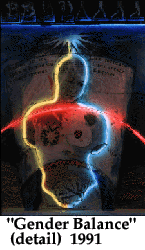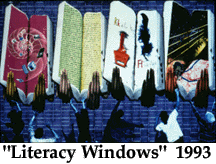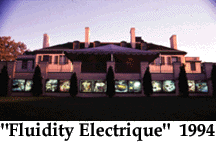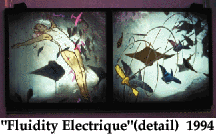

Carolyn P. Speranza is an artist living and working in Pittsburgh,
Pennsylvania where she is the Webmaster and Creative Director for
Pittsburgh.Net. Speranza~s work focuses on community based public
artworks using the computer as a collaborative tool, site specific
installation and multi-media.
Speranza is currently working on "End of the Line: Building Bridges with
Pittsburgh's Busways," a community based collaborative project with
artist Lisa Link and the Pittsburgh Public Libraries. The theme of "End
of the Line" is crossing boundaries between Pittsburgh neighborhoods,
both in the images and, literally, on the buses."End of the Line" will
be shown as a series of large, color computer photomontages which will
circulate the city as billboard displays on PAT city buses. The designs
will address historic and contemporary concerns in Pittsburgh's
neighborhoods. The third in a series of public works by Speranza and
Link, "End of the Line" will be on the road in the Spring of '97.

Some of Speranza's awards and commissions include a recent New Forms
Regional Grant(1996) which is sponsored by the NEA, Rockefeller
Foundation, Warhol Foundation and the Pennsylvania Council on the Arts;
a Faculty Research and Creative Endeavors Grant from Central Michigan
University(1995); a funded residency at Sculpture Space, New York(1995);
a Pennsylvania Council on the Arts grant for a featured installation in
~The Pittsburgh Biennial~(1994) and a commission to collaborate with
inner city students for a ~Literacy~ mural(1992). This project was
reviewed by the New Art Examiner and Speranza coauthored "A Public
Computer Image in Pittsburgh: Literacy Windows" with fellow artist Lisa
Link for ART COM electronic magazine. Additionally, Speranza has
received scholarships for work in light-sculpture at Pilchuck Glass
School(1991 & 3).
Artist's Statement:

My artwork focuses on site-specific light installation, computer art and
community based public artworks. Inventive processes, both artistic and
technological, are at the heart of these activities.
Since 1988 I have been making site-specific installations incorporating
illuminated imagery with three-dimensional elements. The computer is my
primary tool for appropriating, creating and manipulating images. With*
these images, I have examined our age old quest to understand light
through scientific discovery, invention and spiritual relationship with
the sun. I have explored light's seasonal changes and humanity's
attempts to harness, imitate and understand these phenomena. In
combination with digital imagery, I use layers of transparent materials:
glass, gels, and plastics with a variety of light sources: neon
tubing, fluorescents, tiny incandescent bulbs and slide projectors. The
resulting work alludes to science museum displays in its format and
informational presentation.
My current work-in-progress, Hole in My Head, Hole in My Heart, explores
mind/body disorientation featuring two icons: the human heart and head.
The heart is exhibited anatomically in image and in three dimensions.
Representation of the human head includes the brain and more
prominently, a series of self-portrait photographs displaying Alopecia
Areata.** The "Holes," throughout the artwork are both factual and used
in metaphor. First, they are the marked physiological changes
symptomizing Alopecia. Second, these round, smooth patches are the
messengers of a greater, stress-related disorder, the "hole in the
heart." They express the body's distress and intelligence in its
warning. "Hole in My Heart" references emotional stress, related heart
disease and the artist's familial history of open-heart surgery, clogged
arteries, and death by heart attack. Third, these holes are explored as
visual metaphor: in flat, round luminous neon shapes; in cores cast in
rubber and plastic, giving the holes volume and depth; and in spinning
disks.

For the inaugural Pittsburgh Biennial, I created Fluidity Electrique-- a
site-specific work combining digital images and twelve light boxes in a
fifty foot long series of six diptyches. Fluidity Electrique
investigates the shared qualities of lissome, energizing motion in air
and water-- swimming, flying and the passage of light. Fluid motion
expresses the meditative, mind-like-water state, which often precedes
creative activity. In this series, the "floating body" expresses this
metaphor. The sense of immersion which comes with swimming, incubation
in water, is akin to lying in a think tank. Passing through water,
light brings illumination, a breakthrough realization. Moving in this
dreamlike state is not unlike wavering on the edge of sleep where ideas
are free to recombine promiscuously. "Write of swimming under water and
you will have the flight of the bird through the air . . ." wrote
Leonardo in Codex Atlanticus. For DaVinci, swimming was the original
flight simulator. This idea inspires fellow computer artist, Fred
Truck, who uses VR to simulate flying dreams and drew the aerobatic
plane maneuvers in Fluidity Electrique. Having the opportunity to
navigate the cyberspace of Truck~s VR, the sense of floating and
disembodiment strongly reminded me of swimming, Ti-Chi and the Zen
no-mind, flow state of creativity.
My community based public artworks include ~Art in the Heart of the
City,~ a mural produced with urban middle school and rural college
students for a Pittsburgh recreation center; "My Bread Tastes Sweeter",
a billboard collaboration for the Adopting Aliquippa urban renewal
project; and "Literacy Windows," for which I am one of two artists
commissioned by the Times Project. We designed "Literacy Windows" with
inner city high school students using photo-imaging software and
specialized printing on a continuous sheet of vinyl over 25 feet long.
The mural was displayed on the Heinz Plant in Pittsburgh's Northside for
two years. It is now travelling to other culturally diverse
neighborhoods.
 back...
back...






 back...
back...